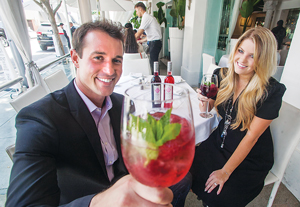Seasoned with spices and sliced fruit, it was sangria only available at the three restaurants co-owned by TV celebrity and Beverly Hills restaurateur Lisa Vanderpump and her husband, Ken Todd.
Now the sangria is going to the second generation.
Vanderpump has handed over the recipe to her daughter, Pandora Vanderpump-Sabo and her husband, Jason Sabo, who have begun bottling the brew in an effort to introduce it to a wider audience.
While Lisa Vanderpump said she gave the recipe to her daughter at no cost, lent her initials to the product and appears in marketing materials without compensation, her largesse does not mean the success of the LVP Sangria brand is assured.
The younger Vanderpump’s West Hollywood company, Vanderpump Wines and Spirits, spent more than a year refining the recipe, made fresh in the restaurants, to stand up to extended periods on the shelf once bottled.
“It took quite a while to get it exactly how we wanted it,” she said. “We wanted something that tasted and looked like a very authentic Spanish sangria, but then again, we’re bottling it so we wanted it to be shelf stable.”
Once bottle ready, LVP faces the next challenge: establishing itself as another niche player in a highly competitive market.
Jeff Gutsch, wine industry national practice leader for accounting and business consulting firm Moss Adams in Santa Rosa, said breaking into the sangria market can be difficult.
“The U.S. is not Europe, where everybody is familiar with a lot of different varietals,” said Gutsch. “And when you take an off-varietal or off-product like sangria, there’s going to be some challenges.”
What might work in Vanderpump-Sabo’s favor, he said, is the celebrity status of her mother, who appears on “Real Housewives of Beverly Hills” and “Vanderpump Rules.” She also competed on “Dancing With the Stars” last year.
Despite the challenges, the brand has had some early success, snagging a distribution deal in June with Compton’s Arden Group Inc., parent of the Gelson’s chain.
That deal was followed by one with Maryland-based chain Total Wine & More that will get it in stores next month. It will also be expanding to other states such as Texas and Nevada, and it is also developing a white sangria flavor, which is expected to debut by the end of this year.
Vanderpump Wines and Spirits was founded more than a year ago and brought in consulting firm Carignan Partners of Century City as an equity partner.
Lazarus Kaufman, Carignan’s president, has worked in the wine industry for more than 35 years, some of that time spent with alcohol company Sidney Frank Importing Co. Inc., which developed Grey Goose vodka and introduced Jägermeister to America.
Kaufman said working with LVP Sangria, which retails for about $13 a bottle, was an opportunity to introduce an upscale product in a market dominated by bottled sangrias that sell for less than $10.
“We thought that this potentially could be great,” he said. “Due to Pandora and Lisa and the (reality) show, they have a very strong following. It’s a very important piece of this whole equation.”
Kaufman wouldn’t say how much Carignan put up for its stake in the business or disclose startup costs and company sales. But he did say that the business was able to cover its production costs with the price it charges wholesalers.
Moss Adams’ Gutsch said entering the market has become more challenging as distributors get bigger and brands must compete for shelf space in retail stores. The federal Alcohol and Tobacco Tax and Trade Bureau approved nearly 99,000 wine label registrations, mostly from foreign producers, last year.
In spite of the challenges, Jason Sabo is confident the brand will find a market.
“It’s a new frontier,” he said. “People don’t really know bottled sangria. They’re not accustomed to it. They drink vodka or wine or beer. … (But) it made sense to put a marketing campaign behind this with the family name and a product we’ve been serving in the restaurant for years.”
LVP Sangria uses a blend of Spanish wines from Valencia, Spain, and it’s bottled at a facility near Bordeaux, France. The product is then shipped to Miami, where the company’s importer is based, and then sent to a warehouse near Napa Valley before going into distribution.
“It’s a process,” she said. “You need to put in the face time to get the results you want. You need to put in the travel and it’s a lot of meetings. We live in L.A., but we’ve only been there three weekends since Jan. 1.”

